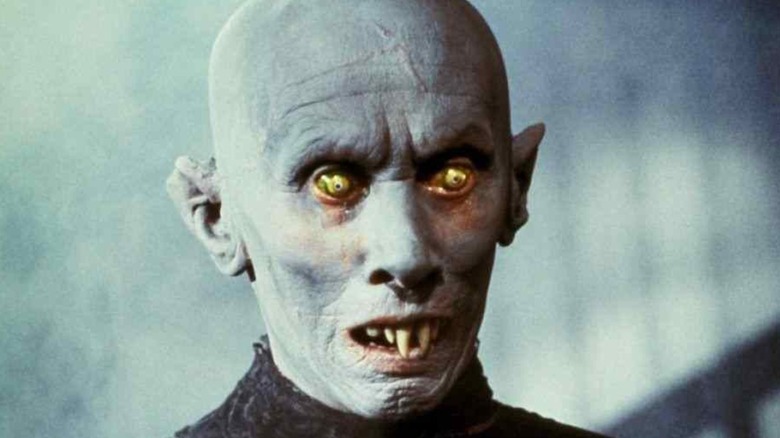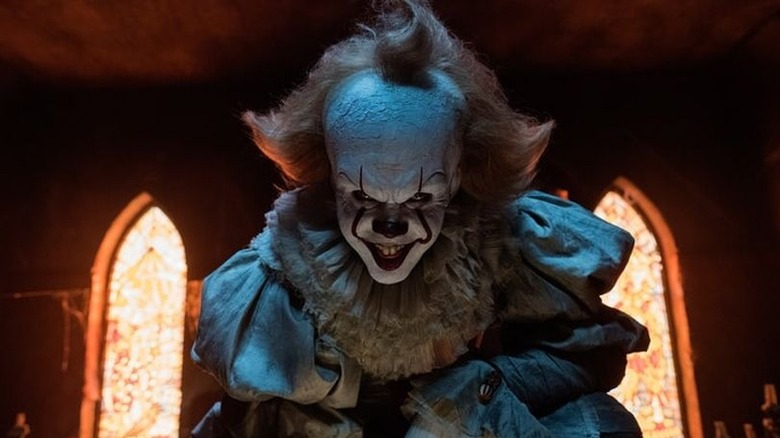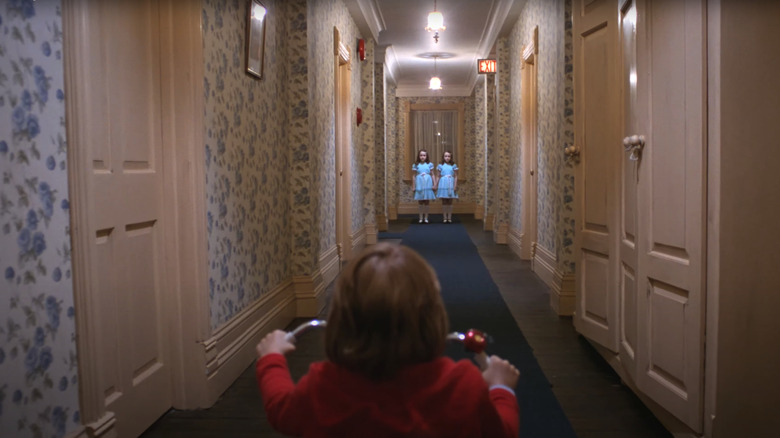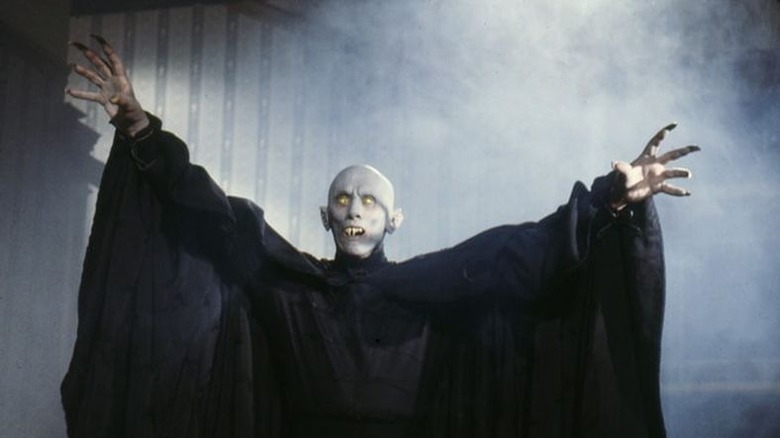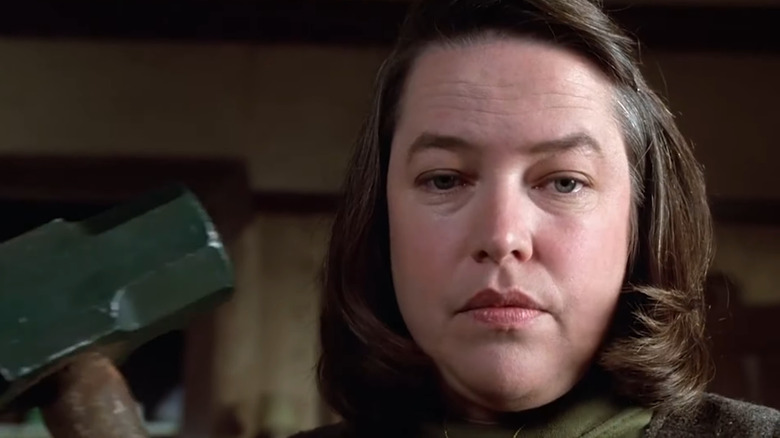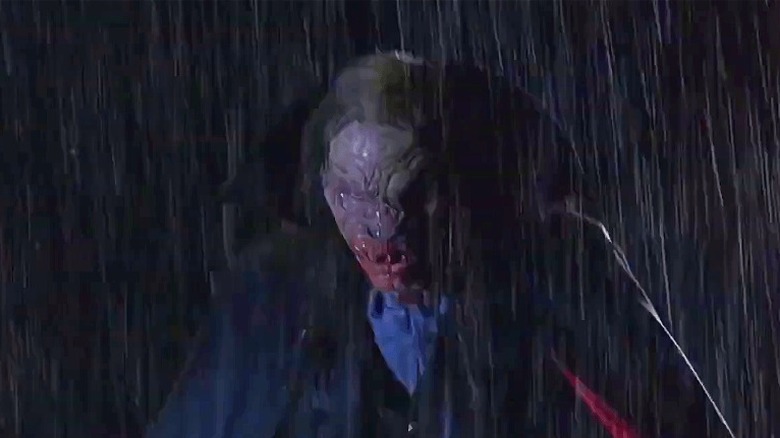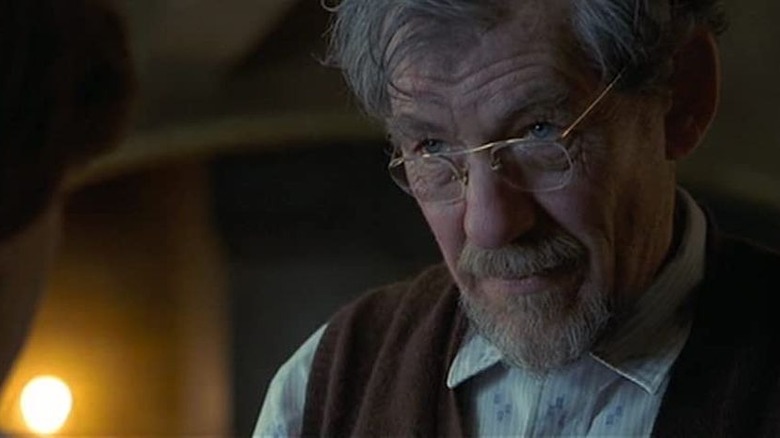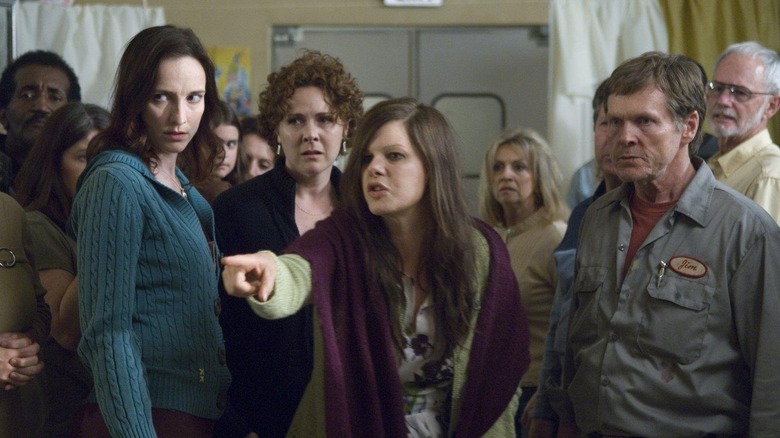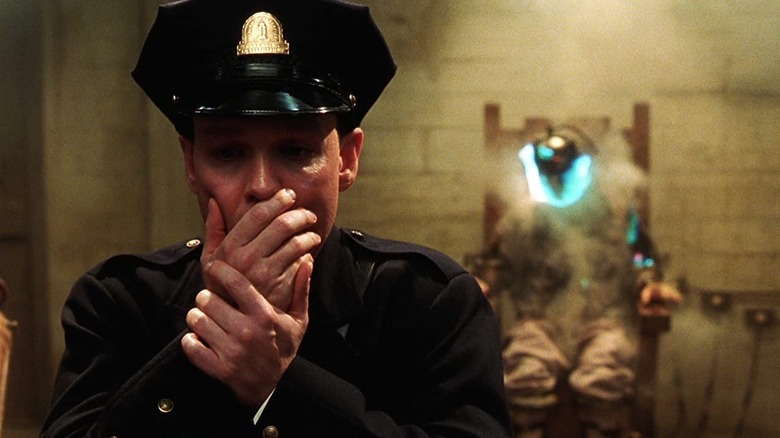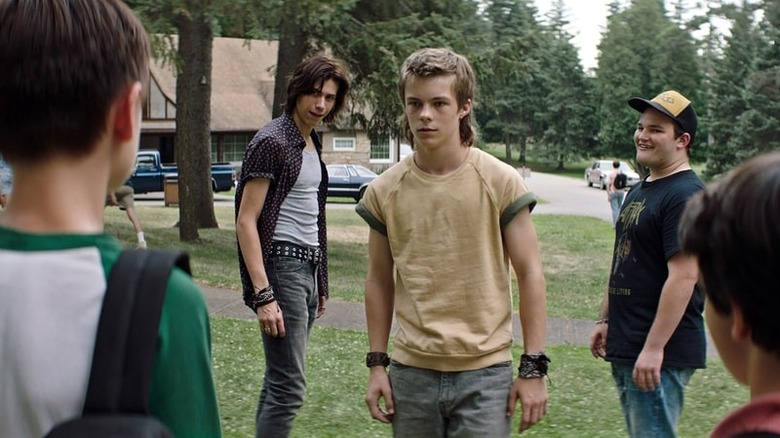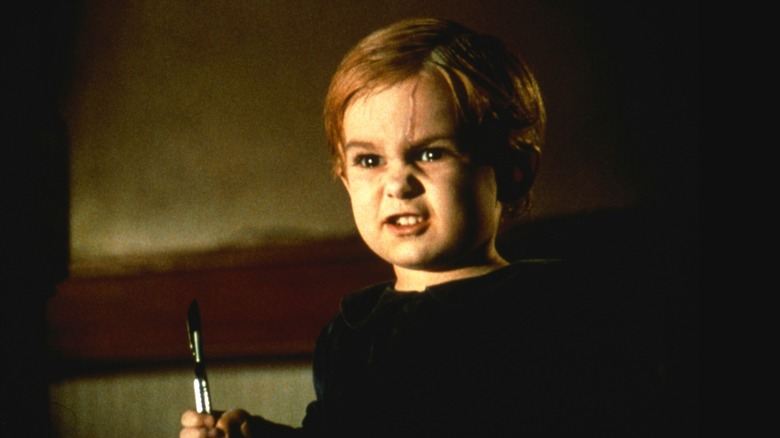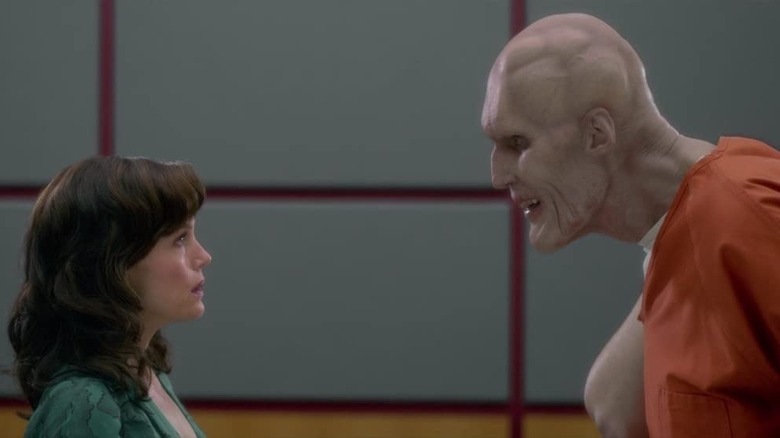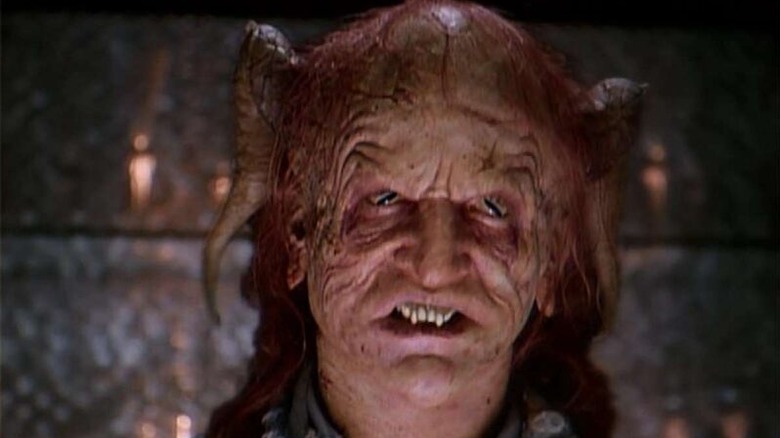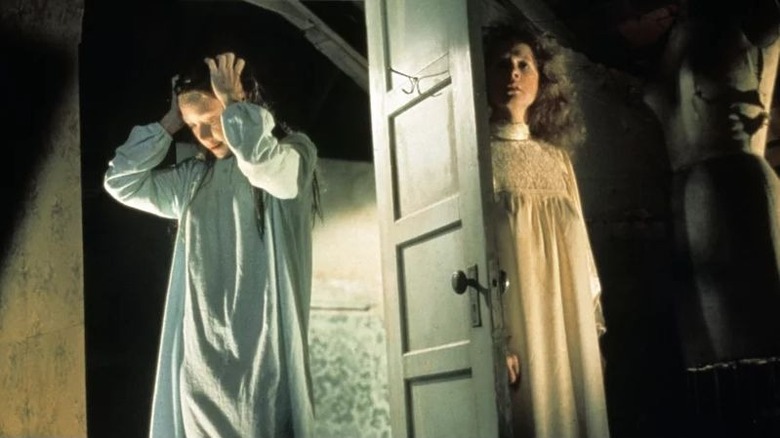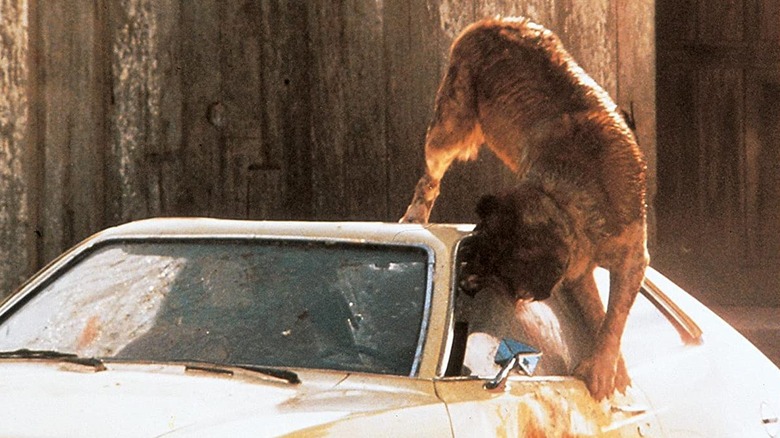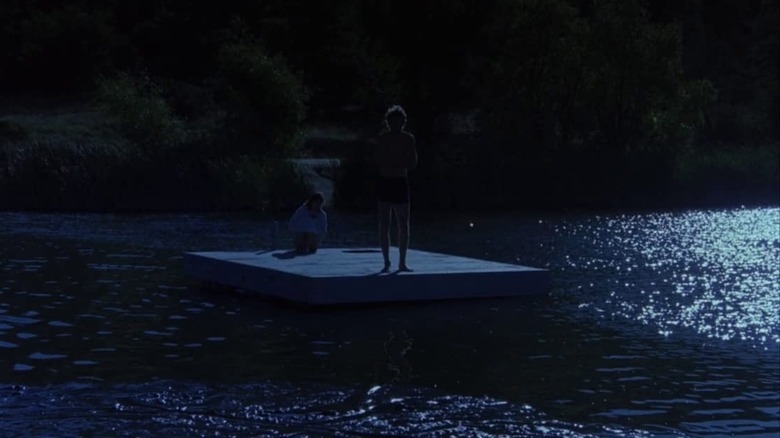The 15 Scariest Stephen King Villains We've Seen On Screen
From the very first adaptation of Stephen King's fiction — Brian De Palma's eternally excellent "Carrie" (1976) — his villains have dug their claws into the collective consciousness, inspiring as many nightmares as the books they're based upon.
Across film and television, there are King adaptations of all kinds: scary, laughable, faithful to the source material, completely off-the-wall ... if you want King, they've got it. But even the ones that don't necessarily work outside of the books are capable of giving chills like nothing else, to the point that creatures like Pennywise and Cujo are likely what most of us think of when we hear "clown" or "rabid animal."
With plenty of new Stephen King adaptations headed to big and small screens alike, we've got a list of the 15 scariest Stephen King villains we've ever seen on screen. What's scary to one person is entirely subjective, but there's a pretty wide spread of freaks and horrors here from our world to the next. And given how quickly King pens new spooky tales, it's likely we'll have plenty of new options to consider for the foreseeable future.
Pennywise the Clown, aka It
Pennywise the Clown may be the most obvious choice for this list, and it's with good reason: this ancient shape-shifter comes from beyond our universe and can take on the form of whatever terrifies us most. A scared human is supposedly a more delectable one, so it's only natural that Pennywise would be the favored appearance for a hungry creature with its sights set on the children of a small town.
Beyond its shape-shifting ability, Pennywise maintains its fresh supply of victims by psychically manipulating the citizens of Derry, Maine. Nobody really seems to notice or care too much about the disappearances of countless children and adults over the hundreds of years following Pennywise's arrival on Earth. It's not until the Loser's Club bands together that the creature truly meets its match.
Portrayed by Tim Curry in the 1990 TV miniseries and Bill Skarsgård in the 2017 feature film (as well as its 2019 sequel), Pennywise's cinematic reign of terror looks poised to continue with Max's "Welcome to Derry" prequel series.
The Overlook Hotel
While Jack Torrance is the primary antagonist of "The Shining," it's ultimately the Overlook Hotel behind his gradual descent into madness. The site of countless murders and atrocities, the hotel manipulates its guests and manifests horrors for its own gruesome means.
As famously depicted in Stanley Kubrick's 1980 film adaptation (which King famously dislikes for its creative changes from the source material), the Overlook takes advantage of Jack Torrance's struggles with alcoholism and physical abuse and turns him into an axe-wielding avatar for its murderous desires. It also manifests the ghosts of its former guests and overseers, such as the infamous Grady twins and the bathing woman in room 237.
We won't spoil the gory details, but the Overlook Hotel also returned in Mike Flanagan's 2019 adaptation of King's sequel "Doctor Sleep," in which an adult Danny Torrance returns to the cursed lodgings in order to stop a group of psychic child-killers called the True Knot.
If you're feeling particularly brave, you could always book a weekend at the Stanley Hotel in Colorado, which served as the inspiration for the Overlook and was even used as a filming location for Mick Garris' 1997 TV miniseries.
Kurt Barlow
Few on-screen King villains are as iconic as the blood-sucking Kurt Barlow in Tobe Hooper's 1979 miniseries adaptation of "Salem's Lot." Between his classic "Nosferatu"-style appearance and how his supernatural influence quietly eats away the small town of Jerusalem's Lot, Barlow is deservedly one of the most feared depictions of the vampire in cinematic history.
While Hooper's version of Barlow (played by the late Reggie Nalder) is far more outwardly monstrous than in the original novel or the 2004 miniseries, it certainly worked in the film's favor. The shockingly yellow eyes, the scarred and discolored skin, the long and misshapen fangs: Barlow's haunting visage is absolutely devoid of any humanity he may have once had. The handsome, charming gentleman vampire stepped aside for Nalder's manifestation of parasitic evil in the '79 miniseries, and we're (arguably) the better for it.
Annie Wilkes
Kathy Bates' obsessive super-fan from "Misery" might not be a prosthetic-clad creature like many on this list, but her outwardly wholesome appearance is all the more disturbing in contrast with the torment she inflicts on author Paul Sheldon.
Wilkes can't believe her luck when she discovers the man she's rescued from a car wreck is her favorite author. Unfortunately for Paul Sheldon, she has a serious bone to pick over his decision to kill off the protagonist of his famous series of romance novels. Trapped by his severe injuries and Wilkes' unstable threats of violence, Sheldon is forced to write a more satisfying continuation of the Misery Chastain novels.
It's no surprise that Kathy Bates won the Academy Award for Best Actress for her performance as Annie Wilkes in Rob Reiner's 1990 film adaptation. She expertly transitions from quirky to terrifying on a dime, delivering one of the most memorable on-screen King villains of all time. There was also a pretty interesting younger take on the character in the second season of Hulu's now-cancelled series "Castle Rock," in which Wilkes was played by Lizzie Caplan.
Sadistic, unpredictable, and entirely convinced that her actions are justified and rational — in a modern world of stan culture and obsessive fandoms, Annie Wilkes is perhaps more plausibly scary than ever.
Dwight Renfield
"The Night Flier" might be one of King's more obscure stories, and it's more on the goofy side than it is outright bone-chilling. But Mark Pavia's 1997 film adaptation (starring Miguel Ferrer of "Twin Peaks" fame) went all-in on the special effects for its aviation-enthusiast vampire villain, resulting in one of the most impressively gruesome and unsettling monsters we've had from a King adaptation. And like many King adaptations, it certainly has a cult following.
Dwight Renfield is the on-the-nose pseudonym of a pilot who's rumored to be responsible for a rash of bizarre killings at local airports and airfields. Ferrer's sleazy reporter Richard Dees is assigned to the case, and although he's initially skeptical of the story, it quickly becomes clear that there's plenty of meat on the urban legend's bones.
Although he does have a normal human form, Renfield's ultimate appearance is a truly horrific beast with a flat snout, grotesquely wrinkled flesh, and enormous fangs on the top and bottom of his jaws to feed on the blood of his victims. It's a look far closer to Francis Ford Coppola's "Bram Stoker's Dracula" than it is "Salem's Lot," and deservedly lands a spot on our list.
Kurt Dussander
Perhaps in part because of director Bryan Singer's reputation, "Apt Pupil" seems to have fallen by the wayside since its release in 1998. But Ian McKellen's performance as Kurt Dussander — an elderly German war criminal in hiding whose dark nature is awoken by a teenage neighbor — is especially disturbing in an age of heightened political extremism and impressionable, embittered youth.
"Apt Pupil" was one of several short stories from King's collection "Different Seasons" to be adapted as a feature film, including tales that became "The Shawshank Redemption" and "Stand by Me." In this particular story, Dussander served in Hitler's SS during World War II, taking part in the atrocities of Holocaust before fleeing for South America and later the United States in order to avoid prosecution for his war crimes. Taking the false identity of Arthur Denker, Dussander has managed to avoid detection until his past is discovered by a local teenager, Todd Bowden, who blackmails him in return for tales of the atrocities he committed during the war.
What's truly disturbing about Dussander isn't just his past, but how easily he slips back into acts of cruelty and violence — and how his influence quickly emboldens Bowden's latent dark side. There's little fantasy behind the evil in "Apt Pupil"; the horrors of yesterday don't vanish simply with the passage of time. In the case of Todd Bowden, all it takes is a little push in the right (or wrong) direction.
Mrs. Carmody
For the protagonists of "The Mist," hiding from ultra-dimensional creatures is terrifying enough. But the terror spills over entirely when Marcia Gay Harden's Mrs. Carmody begins to whip the survivors into a religious frenzy in Frank Darabont's fantastic 2007 film adaptation, which is widely considered to be one of the best adaptations of King's work.
Much like "Carrie" matriarch Margaret White, Mrs. Carmody is driven by a passionate and committed religious interpretation of the world around her. When a scientific experiment goes wrong at the local military base, a strange mist is unleashed upon the town below, manifesting all kinds of bizarre creatures. Shoppers at a local supermarket are trapped inside the building, and as paranoia and fear set in, Mrs. Carmody begins to convince others that the mist and its horrors are God's punishment for the sins of our world — and her followers must help to dish it out.
Marcia Gay Harden's performance as Carmody is phenomenal ; a relentless whirlwind of dogmatic preaching and manipulation of vulnerable survivors. It's equal parts enraging and terrifying to see the protagonists torn between Lovecraftian beasts and their fellow townspeople turning against them. It's a shame the Spike TV series of "The Mist" didn't quite take off in 2017, but Darabont's film was certainly a hard act to follow.
Percy Wetmore
Already proficient in terror as the live-eating Adrian Toomes in "The X-Files," actor Doug Hutchison excelled as cruel and sadistic prison guard Percy Wetmore.
Before "The Mist," writer-director Frank Darabont brought us a feature film adaptation of King's novel "The Green Mile." Starring Tom Hanks and Michael Clarke Duncan, the story concerns the miraculous abilities of a death-row inmate (Duncan) at Cold Mountain Penitentiary in the 1930s.
Hutchison portrays corrections officer Percy Wetmore, a sadistic and cold overseer of the titular "Green Mile" cell block. He takes great pleasure in tormenting the inmates, finding every possible way to inflict pain and suffering on them without losing his job. Even worse, Wetmore's behavior is backed by his familial connections, which not only landed him the gig but keep him in the good graces of Cold Mountain's higher-ups.
Even though he gets his just desserts by the end of the film, it's never not tough to watch scenes like the fate of Mr. Jingles and his sabotage of Del's execution by electric chair.
Henry Bowers
Pennywise is undoubtedly the true villain of "It," but the shape-shifting creature certainly has some help from the very town it preys upon.
Local bully Henry Bowers is both the product and executor of human evil in Derry, Maine. An abusive upbringing have resulted in Bowers becoming a sadistic bully in his teen years, leading his own gang and tormenting the youth of Derry. This makes Bowers a ripe vessel for It's campaign of evil against the Loser's Club and the town, manipulating him to act out his darkest tendencies (much like the Overlook Hotel does in "The Shining").
What makes Henry Bowers so scary is not just the fact that he's reminiscent of every small town's notorious troublemaker, but that he's so tragically a perfect human target for Pennywise's chaotic influence. What could have been a promising young man was practically doomed by his father's abuse, long before Pennywise even set his sights on Bowers. With each adaptation of "It," it's fascinating to see the different ways this depiction of generational trauma and violence can be explored.
Gage Creed
One of King's most disturbing on-screen villains is also one of his most tragic. In "Pet Sematary," the Creed family move into a new home and discover the titular graveyard on their property. Despite warnings from neighbor Jud Crandall about dabbling in its strange properties, Louis Creed reanimates their tragically deceased toddler Gage in an act of hubris by burying the child in the cemetery.
Gage is frightening on two levels: the most obvious is his possession by the spirit that lies in the graveyard, leading him on a deadly rampage against the Creed's neighbor Jud Crandall as well as his own parents. The former innocence of Gage is gone, replaced with malicious intent from beyond the grave. But what's truly frightening about Gage is the thought of an act of love for your child turning into an unforgivable nightmare.
The 2019 remake of "Pet Sematary" swapped the roles of Gage and his older sister Ellie – among other changes from the novel and the original film adaptation – but Miko Hughes' portrayal of the vengeful Gage in Mary Lambert's 1989 original will never die.
The Space Cowboy
There are plenty of horrifying moments in Mike Flanagan's 2017 adaptation of "Gerald's Game" (we'll never look at handcuffs the same again) but the reveal of the Space Cowboy truly takes the cake.
Depicted on-screen by "Twin Peaks" legend Carel Struycken, Raymond Andrew Joubert (nicknamed The Space Cowboy) is a serial killer whose numerous crimes tick just about every depraved box there is. But his most terrifying act is simply his presence throughout Julie Burlingame's struggle to escape the confines of a pair of handcuffs after her husband dies of a heart attack during a compromising act.
While he's capable of murder, cannibalism and other things we'd rather not go too deep into, in "Gerald's Game" the Space Cowboy prefers to watch Julie's torment from the shadows. As Julie's predicament becomes more and more desperate, the lines between what's real and what's not begin to blur, and the entity of the Space Cowboy is all the more haunting. It's a great example of King's ability to combine fears real, imagined and somewhere in-between.
Randall Flagg
There are too many depictions of Randall Flagg to cover across all media here, but that's partly why Flagg is one of King's most beloved antagonists.
An all-powerful, many-faced servant of the Crimson King from the "Dark Tower" series, Flagg is directly and indirectly responsible for many of the terrifying events throughout King's fiction and its many adaptations. And while he might not look so physically imposing in Mick Garris' 1994 TV adaptation of "The Stand" or the more recent CBS miniseries, that's kind of the point. Flagg is charismatic, mysterious, and gains support through his ability to give people exactly what they desire.
He could be described as the King universe's equivalent of the Biblical Satan, but truthfully, Flagg is far more complex than that. He sows discord and chaos across time and space, taking on many forms and names and corrupting everything he touches. His most recent appearances on screens include the 2017 "Dark Tower" film, in which he was played by Matthew McConaughey, and the 2020 miniseries adaptation of "The Stand," in which he was played by Alexander Skarsgård. There's no doubt that Flagg will find his way to our screens again one way or another.
Margaret White
"Carrie" was the first adaptation of King's work, and thanks to Brian De Palma's typically superb direction and lead performances from Sissy Spacek and Piper Laurie, it's still one of the best to date. Even King himself appears to agree.
Carrie is the repressed daughter of Margaret White, a religious fanatic who has fallen apart after her former husband's departure from the family. Carrie demonstrates an untapped telekinetic ability, which begins to manifest itself in response to bullying by other girls at school. The fanaticism is only intensified when Carrie pushes back against her restrictions, insisting on being allowed to attend the school prom and demonstrating her telekinetic abilities to prove she cannot be controlled.
Piper Laurie delivers a superb portrayal of Margaret, a character who appears merely eccentric to the neighborhood but terrorizes her daughter behind closed doors. Her own trauma is weaponized against Carrie, punishing her for any transgressions by locking her in a closet to pray for forgiveness. Unlike Mrs. Carmody from "The Mist," she's rejected by almost everybody except Carrie, who is torn between wanting her mother's love and being absolutely terrified of the monster she's become. In light of her repressive upbringing, Carrie's fiery vengeance at the film's climax is no surprise.
Cujo
Sure, the threat of Cujo seems a little small-scale when compared to the likes of Pennywise the Clown and Randall Flagg. But this is a good example of how King writes stories that scare on broader and more personal levels: the threat of the beloved family pet.
Cujo and Gage Creed from "Pet Sematary" are alike in that neither is responsible for their monstrous transformations — in Cujo's case, rabies after being bitten by a diseased bat — but they're all the more frightening and dangerous for how innocent they once were.
In the 1983 film adaptation, which went through quite a few changes from the novel, Donna Trenton and her son Brett are terrorized by the formerly adorable St. Bernard — who's understandably still the go-to reference for rabid dogs, even all these years. It's not exactly easy to pull off the special effects for a movie dealing with a dog like Cujo, but director Lewis Teague did a damn fine job in capturing the horrifying transformation of the titular hound: a threat that most owners would struggle to bring themselves to fight back against.
The Slime
There are plenty of fantastic segments to choose from between "Creepshow" and "Creepshow 2," the horror anthology classics featuring stories by King. The oily slime from the second segment of 1987's "Creepshow 2" is beyond explanation — and that's exactly why it lands a spot on this list.
Adapted from the short story "The Raft" from King's 1985 short story collection "Skeleton Crew," this segment of "Creepshow 2" follows a group of teens who fall prey to a bizarre, all-consuming sludge in the lake they've decided to hang out on. The protagonists are slowly consumed by this formless entity as they hopelessly cling to the lake raft, watching in horror as it toys with them from the water's surface.
It's often the things we don't understand that scare us the most, and for that reason this segment still gives chills even with the campy tone of the "Creepshow" series. Is it hungry? Is it territorial? Where does it come from? Is it alive? None of these questions truly matter when you're trying to find a way back to the shore as your friend is sucked down into the maw of this horrifying villain.
If you're a "Creepshow" fan and haven't yet checked out the Shudder TV revival, keep your horror-loving eyes peeled for the forthcoming third season.
